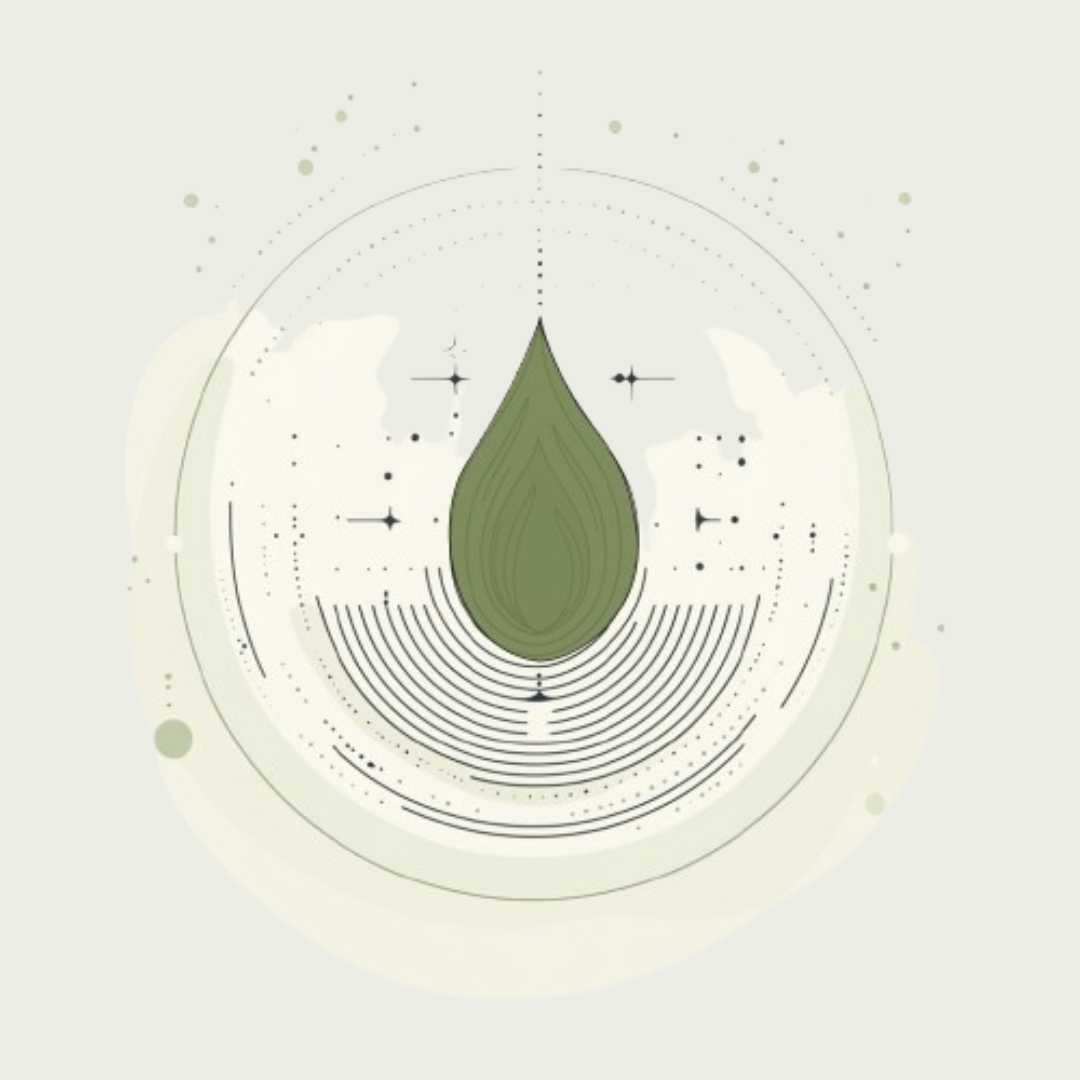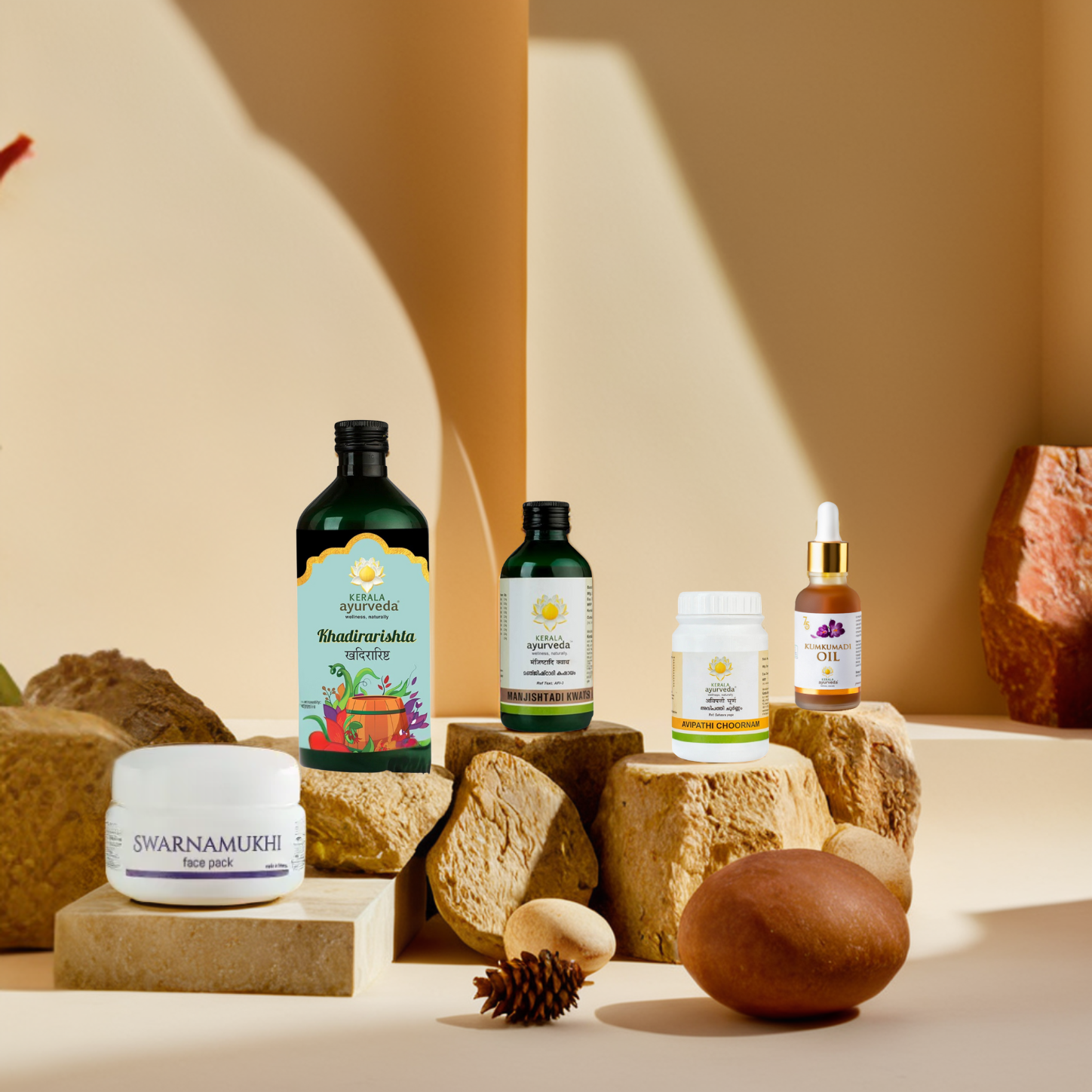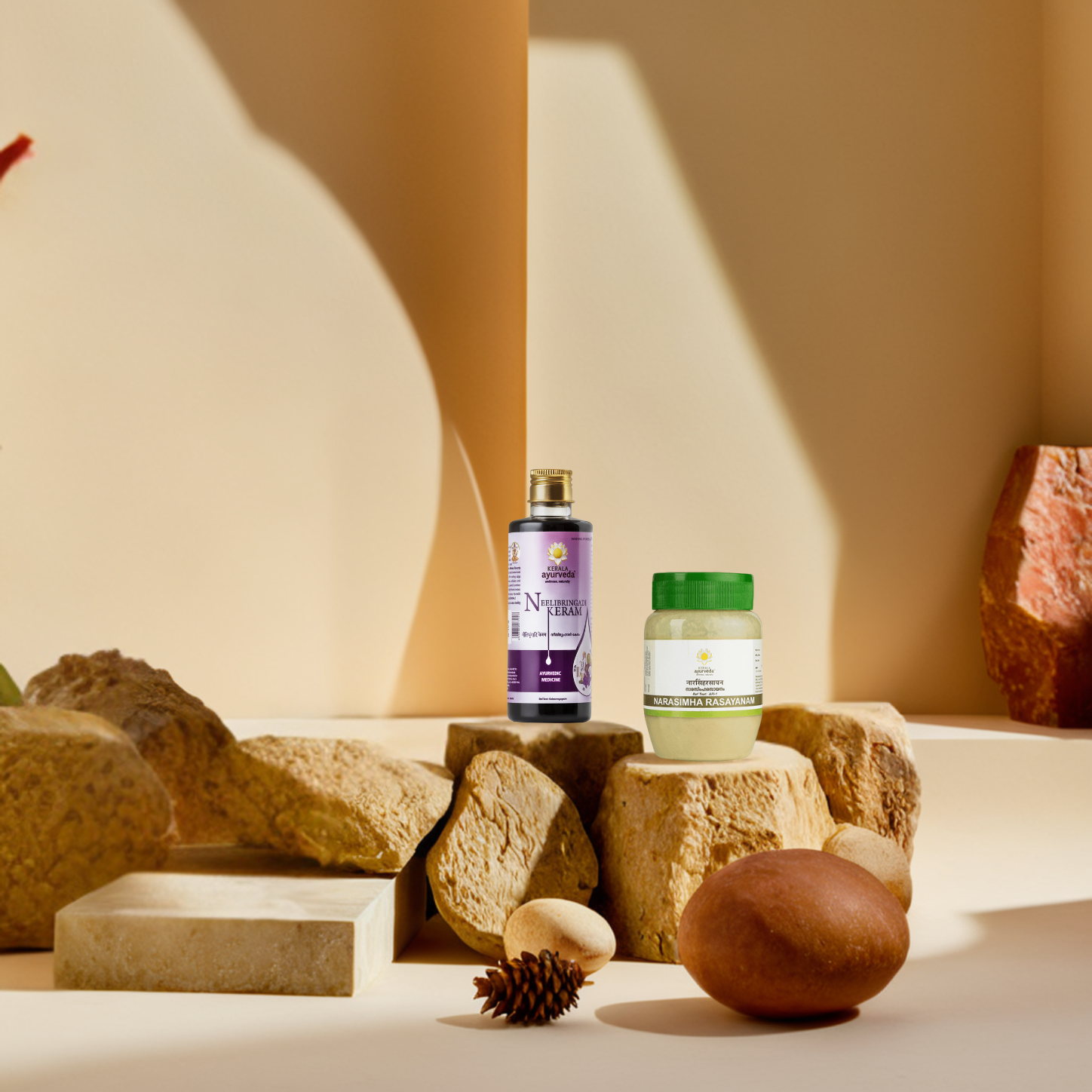Highlights
What Is Dhanwantharam Thailam?
Dhanwantharam Thailam is an Ayurvedic formulation of potent herbs and ingredients. This unique formulation with around 28 herbs is used to manage Vata Dosha-related issues. It is named after the patron or Father of Ayurveda, Dhanwanthari who is said to have carried the nectar of immortality. Dhanwantharam Thailam is used in many Ayurvedic therapies such as Abhyangam, Pichu, Sneha Vasthi, Kashaya Vasthi, and Kati Vasthi. It is also a traditional home remedy oil regularly used by women during pregnancy and post-delivery. Uses of Dhanwantharam Thailam in traditional medicine include massage to support strength and vitality in the body.
Most Vata-related disorders cause the person to experience acute or chronic pain accompanied by stiffness and an inability to move easily. Vata problems severely impact the mobility of a person. This makes daily life difficult and painful. While conventional medication alleviates the pain, there are many side effects. Ayurveda uses herbal oils such as the Dhanwantharam Thailam to manage the pain and ease the stiffness caused by the Vata disorder. It can be used internally (orally) and externally for the massage. Its internal oral intake and its external application both are beneficial in the treatment of paralysis, hemiplegia, quadriplegia, and wasting or physical weakness. It improves the strength of muscles, ligaments, tendons, and other tissues in the body. It also acts as nervine and neuroprotective, so it plays a vital role in the neuroprotection and preserving the natural functions of the nervous system. It also supports the musculoskeletal system, so it is also beneficial in the pain disorders like arthritis, osteoarthritis, knee pain, backache, and spondylosis.
Before we dive deep into Dhanwantharam Thailam’s use and more benefits, let’s first get an understanding of how the human body functions according to Ayurveda.
Human Body And Ayurveda
The Doshas
Ayurveda is a science that considers the human body as a whole. It is a holistic system that encompasses the physical, emotional, and mental well-being of a person. Ayurveda defines three Doshas as the primary functional energies of all beings. Each person has Dosha levels that are unique to them and their constitution. The Doshas control the life processes in the mind and body.
When a person’s Dosha levels are not at their optimal levels, disease and ill health affect the person. Ayurveda is a system of therapies that help each individual keep their Doshas’ unique optimum levels.
The Vata Dosha relates to the air element, the Pitta Dosha to the fire element, and the Kapha Dosha to the water element. Since the Vata Dosha governs the Pitta and Kapha Doshas any disturbance to this Dosha has more severe implications. When the Doshas get aggravated from the healthy level for each individual, they cause issues with the processes and features of the body that they govern. For example, since Vata governs coordination and movement too much of the Vata Dosha causes hyperactivity.
Dosha karma pacifies Vata. Dhatu Karma acts to the level of Mamsa and Asthi. Pradhana karma acts on Vata Vyadhi.
The Dhatus
Ayurveda describes the human body as composed of seven tissues or Dhatus. These tissues are in concentric layers. The Dhatus are:
- Rasa: Plasma or Skin
- Rakta: Blood
- Mamsa: Muscle
- Medha: Fat
- Asthi: Bone
- Majja: Marrow and nerves
- Shukra: Reproductive tissues
These tissues are governed by the three Doshas as follows:
Kapha: Plasma, muscle, fat, marrow, and reproductive tissues
Pitta: Blood
Vata: Bone
Disease and health issues in Ayurveda refer to the Dosha and the bodily tissue that the Dosha has affected.
The Shrotas and Malas
The channels that carry nutrition and other materials to and from the body tissues are called Shrotas. Normal flow through the respective Shrotas keeps the body in optimum health. When a Shrota is blocked or functioning in a manner that is less or more than the optimum, ill-health results. The waste materials carried out of the body are sweat, urine, and faeces and they are called the Malas.
Dhanwantharam Oil Benefits: How Can Dhanwantharam Thailam Help The Body?
As per Ayurveda, health issues are caused by a Dosha or a combination of Doshas out of their optimal levels. Most Vata problems affect the parts and processes of the body that the Dosha governs. Vata disorders cause hampering of movement, dryness, cold and wasted tissues. Some common Vata problems are nervous disorders, paralysis, epilepsy, muscle pain, chronic pain, shoulder dislocation pain, rheumatoid arthritis, osteoarthritis, neck pain, spondylosis, and other bone and joint-related issues. Dhanwantharam Thailam is the preferred Ayurvedic oil used for application externally on the affected part to manage pain and stiffness. Dhanwantharam Thailam benefits for skin are many which make it a popular Abhyanga oil.
Dhanwantharam Thailam benefits a patient recovering from a viral infection who suffers from joint and muscle pains. Dhanwantharam Thailam uses include being a traditional oil to be applied for neuralgia, paralysis, weakness, quadriplegia, hemiplegia, palsy, and other Vata-caused nervous system weaknesses.
Dhanwantharam Thailam: How To Use In Daily Life
Dhanwantram tailam can be used internally and externally.
Internally, it can be used for the following disorders:
-
Paralysis
-
Facial Paralysis
-
Quadriplegia
-
Hemiplegia
-
Tissue Wasting (or consumption)
-
Muscular Weakness
-
Muscular Pains
-
Spondylosis – Cervical, thoracic, or lumbar
-
Backache
-
Rheumatic diseases – Osteoarthritis & Joint Pains
-
Hernia
-
Hydrocele
-
Endometriosis
Externally, it is used most commonly as a massage oil for:
-
Quadriplegia
-
Hemiplegia
-
Muscular Weakness
-
Muscular Pains
-
Backache
-
Osteoarthritis
-
Knee Pain
A special Dhanwantharam Thailam called Dhanwantharam Thailam 101 undergoes a special process 101 times. This potent herbal 101 version is suitable for internal use with the dosage in drops, under the supervision of an Ayurvedic doctor.
Dhanwantharam Thailam is applied as a massage oil externally on the body area that is affected by the Vata disorder. The use of Dhanwantharam Thailam for hair helps promote hair growth and delays greying. Some people prefer Dhanwantharam Kuzhambu instead of Dhanwantharam Thailam. Dhanwantharam Kuzhambu uses are very similar to that of the Thailam. One can use the Thailam or Dhanwantharam Kuzhambu for face in case of Vata skin issues.
How Can the Ingredients Help You?
Dhanwantharam Thailam ingredients are as follows:
Bala Moola (Sida cordifolia)
- Bala is also called Country Mallow.
- Moola is the root of the herb.
- Bala is a herb used in Ayurveda for its antipyretic, antiviral, antirheumatic, antioxidant, analgesic, diuretic, hypoglycaemic, immunoenhancing, hepatoprotective properties.
- It is useful in neuromuscular as well as neurodegenerative disorders owing to its neuroprotective properties. It is useful for the nerves, muscles and joints.
- It is a traditional herb principally used in the Vata Dosha disorders.
Yaya (Hordeum vulgare)
- Barley
- It is useful in traditional medicine as a fat scraper ingredient in helping to deal with obesity, nourishing the tissues and acts as a helpful natural diuretic and antipyretic.
- It is useful and helpful in the Ayurvedic treatment of respiratory disorders, diabetes, cough, blood diseases, throat problems, asthma, pain, running nose, thigh stiffness, joint pain, prickly heat, fungal infections, jaundice, measles, nephritis, hepatitis, gout, urinary tract infections, obesity and digestive issues such as colic and dysentery. It is useful in folk medicine as a contraceptive aid and for ulcers and haemorrhoids.
- Ayurvedic medicine uses barley to support proper bowel movement, helps enhance voice, strength, complexion, intelligence, intelligence and also as an aphrodisiac.
- It maintains the healthy level Vata Dosha and helps alleviate the symptoms of Kapha and Pitta vitiation.
Kola (Zyziphus jujuba)
- The Indian Jujube or Chinese apple which is high in Vitamin C
- It is useful in Ayurvedic formulations for excessive thirst, fever and bleeding disorders
- It pacifies the aggravated Vata as well as Kapha Doshas and does not increase the Pitta Doshas.
Kulattha (Dolichos biflorus)
- Horse gram
- It is rich in calcium, ascorbic acid and lysine.
- It is used in Ayurveda to help ease the symptoms of kidney stones, piles and asthma.
- It is a natural laxative and helps promote movement in the body’s channels or Shrotas.
- It is useful in Ayurveda treatments to help induce sweating and also for non-bleeding piles and constipation but can be avoided in bleeding piles.
- It is used in Ayurveda to reduce the vitiated Kapha and Vata Doshas.
- A paste of these seeds is used in folk medicine to help reduce swelling.
Dasamoolam
The Dasamoolam are the ten (Dasa) very potent roots (Moolam) central to many important Ayurvedic preparations.
● Bilva (Aegle marmelos)
- The Bael or Bilva tree
- By maintaining the optimum levels of Pitta Dosha, it is believed to help ease ulcers, inflammation, and Pitta-related fevers in Ayurvedic medicine.
● Syonaka (Oroxylum indicum)
- This herb has natural anti-inflammatory and pain relief properties.
● Gambhari (Gmelina arbora)
- It is a general Ayurvedic tonic for relief from weakness
- It relieves Vata and Pitta Dosha imbalances.
● Patala (Stereospermum suaveolens)
- It is believed to be a natural diuretic, cardiac tonic and anti-inflammatory properties
- It is used in Ayurvedic medicine in blood-related problems
● Agnimantha (Premna integrifolia)
- It has anti-inflammatory and pain-relieving properties as per traditional medicine
- It is used in Vata-related disorders
● Salaparni (Desmodium gangeticum)
- This herb is used in Ayurveda as an anthelmintic, immunity-stimulating, anti-catarrhal, antioxidant, febrifuge, carminative, expectorant, nervine tonic, diuretic, anti-diarrheal and stomachic.
- It balances Vata and Kapha Doshas
● Prasniparni (Uraria picta)
- It is used in traditional medicine as an anti-inflammatory and anti-infective
● Brahati (Solanum indicum)
- It is an Ayurvedic anti-inflammatory herb
● Kantakari (Solanum surattense)
- It is used in traditional medicine as a herbal antitumorigenic, hepatoprotective, antioxidant, anti-inflammatory, diuretic and antipyretic.
● Goksura (Tribulus terrestis)
- Helps maintain optimal levels of Vata and Pitta Doshas
Tila Thaila (Sesamum indicum)
- Sesame oil
- It is warm in nature
- It pacifies vitated Kapha and Vata Doshas
- Is used in Ayurveda for neuromuscular disorders. It is said to be strengthening and gets well absorbed by the tissues.
Mahameda (Polygonatum verticillatum)
- Anti-ageing or Jeevaneeya herb
- It is useful in traditional therapies to help replenish and nourish the tissues
- It is useful as a natural nerve tonic, galactagogue, stabilizer, tissue builder, diuretic coolant, rejuvenating, complexion enhancer, expectorant and aphrodisiac
Daru (Cedrus deodara)
- Deodar tree
- Relieves the Ama or metabolic toxin in the body
- Used in Ayurveda for treatment of neurological disorders and arthritis.
- Helps relieve swelling and used in Ayurveda as an anti-inflammatory
Manjishta (Rubia cordifolia)
- Useful in Ayurveda as a blood detoxifier
- It calms the Pitta in the body and helps keep the healthy levels of the Kapha and Pitta Doshas
- Is used in traditional medicines to help improve the complexion and voice. It is used in Ayurveda to ease skin problems, blood sugar issues, ear pain, eye pain, inflammatory problems, urinary tract and gynecological disorders.
Ksheerakakoli (Lilium polyphyllum)
- Traditional rejuvenator or Jeevaneeya Gana, galactagogue and anti-ageing herb
Sweta Chandana (Santalum album)
- Sandalwood
- Traditionally used in the treatment of skin disorders as a coolant, for headaches and migraines
- It is also used in perfume
Sariva (Hemidesmus indicus)
- Is useful in Ayurvedic therapies for skin diseases, itching, sugar issues, urinary tract issues, digestive problems, respiratory problems, fever, excessive thirst, burning sensation and as a detoxifier to help cleanse breast milk and help improve sperm quality and quantity.
- Is an Ayurvedic blood purifier, coolant diaphoretic, demulcent, alterative, diuretic and anti-pyretic
Kushta (Saussurea lappa)
- Is used in Ayurveda to ease gout, respiratory problems and skin issues, increasing sperm count, and in fat reduction
- It is useful in traditional medicine as a hepato-protective, antiviral, cardio-tonic, anti-inflammatory, anti-fatigue, analgesic and anti-hypertensive herb
- It is also used as an excellent rejuvenating herb that helps reduce fat
- It is used in folk medicine as a hair wash to help prevent greying of hair
- This herb has a perfume that makes it valuable in the perfume industry
Tagara (Valeriana wallichi)
- Used in Ayurveda for weakness and wounds
- Helps control the toxins in the body
- Is used in Ayurveda as a rejuvenator
Rishabhaka (Manilkara hexandra)
- It is useful in Ayurvedic therapy for emaciation, thirst, blood disorders, alcohol intoxication, fainting, jaundice, fever, arthritis, bronchitis dizziness, fainting and bleeding disorders.
- It is used in folk medicine to support increase body weight and bulk, nourish, improve taste, and be a cardiac tonic.
Saindava lavana (Rock salt)
- Soothes digestive disorders
Kalanusari (Valeriana wallichi)
- Used in Ayurveda to treat weakness and wounds
- Helps control the toxins in the body
- It is used in Ayurveda as a rejuvenator
Shaileya (Convolvulus pluricaulis)
- Useful in traditional formulations for neurodegenerative diseases, mania, schizophrenia, neurological disorders, memory and learning issues, throat problems
- It is also described in Ayurveda as a herb that helps to improve voice, soothe eyes, improve vision, cardiotonic, strengthen the respiratory system and improve spermatogenesis,
- It is used in traditional medicine as a blood purifier and helps in skin problems.
- Ayurveda states that this herb detoxifies and cleanses the brain and all other areas around it.
- It is useful in the treatment of Vata vitiated disorders
Vacha (Acorus calamus)
- It is also called Sweet Flag.
- It is characterized by an unpleasant smell and is only used in Ayurveda after a purification process as described in the ancient texts.
- Used in Ayurveda as a herbal anti-inflammatory, anti-epileptic and digestive.
- It is useful in Ayurvedic formulations for obesity, piles, Nasya therapies, and relief of cold.
- It is said to help improve intelligence, support digestion, help relieve bloating, relieve colic pain, ease constipation and bloat, and improve the voice. It is used in folk medicine to help in psychological disorders, neuralgia, schizophrenia, epilepsy, paralysis and psychological imbalances.
- It is also used in powdered form for external Ayurvedic Dhanwantharam Kuzhambu massage therapies for obesity.




